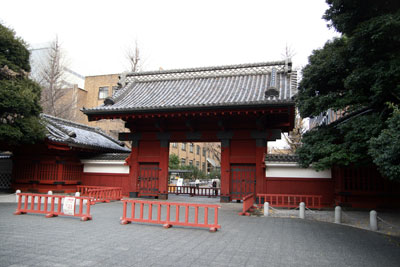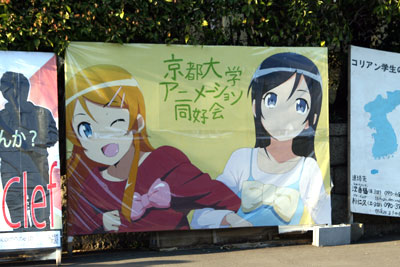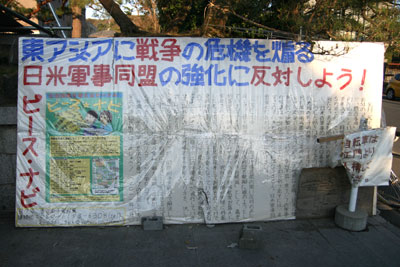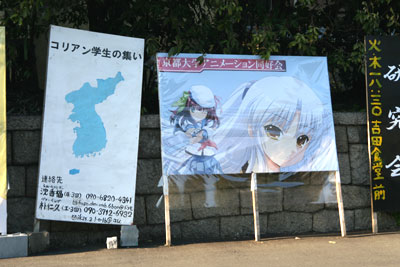
Toudai’s Akamon, circa 2008
Once in a while, people tell me that they want to study in Japan. Most of the time, they speak no Japanese. Fortunately for these people, the Japanese government has been actively pushing a programme that will see numerous top Japanese universities offer full undergraduate courses in English.
Known as the Global 30 Project, the initiative by MEXT intends to bring 300,000 international students to Japan by 2020.
Introduction
Currently, 13 schools have been selected to participate in the project, including University of Tokyo (æ±äº¬å¤§å¦), Kyoto University (京都大å¦), Keio University (慶應義塾大å¦) and Waseda University (早稲田大å¦).

Recruitment poster for Kyoto U’s anime interest group, circa 2011
Waseda University actually started its own English degree programmes in 2004, under the School of International Liberal Studies (SILS) and for a long time was the only option for lazy Americans who want to study in Tokyo without knowing a word of Japanese.
Among the rest of the schools selected for the Global 30 Project, the level of commitment appears to vary quite a fair bit, with some schools offering just a few niche degree programmes, while others are attempting to emulate Waseda in establishing a standalone international college.
Most of the schools are offering some form of liberal arts education, but Nagoya University (åå¤å±‹å¤§å¦) is taking in students for the 2011 school year for both undergraduate and graduate research programmes in science and engineering. I believe Nagoya University is also the fastest school (excluding those with existing English programmes) in getting its programme up and running under the initiative, as other schools such as University of Tokyo and Ritsumeikan University (立命館大å¦) will only start taking in students next year.
Incidentally, a professor from Ritsumeikan will be in Singapore this Friday to explain and promote the school’s new English-based programme.

Lawson at Toudai’s Hongo Campus, complete with Toudai’s logo
University of Tokyo
University of Tokyo (aka Toudai) has come up with a Web 2.0-style logo for what it calls PEAK (Programs in English at Komaba), which is a really fancy way of saying that international students enrolled in its new English degree programmes will get to spend four years in Toudai’s secondary campus, far away from the main Hongo campus with its iconic Akamon and Yasuda Auditorium.
Other than a handful of graduate students, Komaba is where freshmen and sophomores study before moving on to Hongo. This means that foreign students in PEAK will probably be left alone at Komaba after the second year… Not to mention the fact that extracurriculars and club activities mostly take place at the main campus, so it’s going to be a pain in the ass. (See map.)
PEAK will start admitting students in Fall 2012. The application forms will be made available on the website starting from 1 Aug 2011.

Recruitment poster for Toudai’s animation club I found at Komaba Campus this past spring
School Terms
Interestingly, most English programmes such as PEAK are choosing to follow American and European college terms even though school years in Japan all start in April. Toudai is even evaluating the (remote) possibility of moving the entire school to a fall intake system in order to become more internationalized.
Personally, I don’t see how this will ever fly given that the entire corporate recruitment cycle in Japan is dependant on having April as the start of the fiscal year. Toudai graduates would be at a disadvantage if they graduated five months after everyone else in their batch had already found a job. Of course, given Toudai’s awe-inspiring reputation in Japan, it might just end up causing the entire employment system to change to suit its fancy.
Opinions
The main problem with English programmes run by Japanese schools is that they end up being even more isolated from the rest of the school when foreign students have enough trouble fitting in as it is. (Okay, I suppose the real main problem is that most professors in Japan can’t teach in English.) The entire college experience becomes very different for these students, especially when their classes are physically located away from the rest of the student body. It’s almost like a foreigner ghetto of sorts.

Leftist students at Kyoto University protesting the mutual security treaty between Japan and the USA that will lead to Japan being dragged into a war
Entry requirements for undergraduate programmes in English are generally less stringent than their equivalent Japanese-language counterparts at the same school. This is because very few foreigners can score well in the horrifying mess of rote learning known as the National Center Test for University Admissions that Japanese high school students spend their whole lives preparing for while resisting the urge to fling themselves in front of an incoming train on the Chuo Line.
This means that programmes such as SILS generally have some form of stigma attached to them when it comes to seeking employment in Japan, where brand name elitism and social stratification have been perfected to an exact science. In a country that ranks not just universities but every individual faculty of every school on a national level, SILS is not the “real” Waseda.
Of course, employers back home are unlikely to know the subtle difference between Toudai and Toudai Komaba, so PEAK participants will no doubt be able to proudly proclaim that they are Toudai students, drawing loud cheers of adulation from fellow fans of Love Hina.

Bicycles parked on Toudai grounds have stickers that indicate the faculty of their owners
Engineering Diversity
For the Japanese government, the long-term strategic consideration for pushing internationalism and English programmes in school is the country’s rapidly ageing population. The country needs skill immigrants and foreign business partners familiar with its cultural intricacies, but the language and cultural barriers make it a very difficult for foreign students to choose Japan for their college education.
I am kind of cynical about such initiatives. At some level, it starts off as an idealistic pursue of internationalism and cultural exchange mixed with long-term pragmatic goals, but the implementation often degenerates into yet another bureaucratic performance index, where the figures and statistics take on an importance of their own. Global 30 may indeed bring 300,000 foreign students to Japan by 2020, but it’s hard to imagine the quality of education they will receive in English in a country where few can speak the language at the high school level.
Will the English programmes provide meaningful value for the foreign students and the larger Japanese college education system? Or will they serve as a superficial facade of diversity — The equivalent of a token black guy being Photoshopped into a student handbook cover photo to showcase the school’s diversity? I guess we will find out in a decade or two.
For now, the Japanese government can throw a bunch of impressive numbers around, the participating schools can claim to be international education hubs and the foreign students have an easier backdoor into brand-name Japanese schools. Win-win all around, I suppose.

Another poster for Kyoto U’s anime interest group, next to a poster for the Korean student group
Conclusion
Okay, so it’s not all bad if you ignore my cynical asides, which can really be said for most things in life.
In fact, for non-Japanese speakers genuinely interested in studying in Japan, programmes such as Waseda’s SILS are actually pretty nice options to have. You do get the opportunity to live and study in Japan and you will eventually pick up the language during your time there. You will also make friends with a lot of Koreans.
If you are interested in studying in Japan and you don’t speak Japanese, take a look through the official sites:
- JUMP (MEXT’s Global 30 site for prospective students)
- Waseda University SILS
- University of Tokyo PEAK
- Nagoya University’s Global 30 page
Those looking for ways to fund their studies can consider the Monbukagakusho (MEXT) scholarship for foreigners. It’s a full-ride scholarship from the Japanese government with no strings attached.
I guess this post was really just an excuse for me to post the highly irrelevant photos I took at various Japanese universities over the years.

Moving the school year seems like something they have to do if they want to accommodate more westerners… Americans don’t get to graduate high school until June, for example. It’s just a couple months of a gap I guess.
In my school (one of those mentioned above), there is a bench called 外ベンムwhich is mostly populated by exchange students (most of them westerners), and a few Japanese students seeking to either improve their English, or make new friends in spite of their English.
It’s like another planet.
Exchange students (and I suppose the new English-medium intake will be too) are allowed to take classes with the rest of the school population provided their Japanese is up to scratch. Still, most classes do not provide a conducive environment for interaction – a lecture theatre of 200, anyone? – and hence the exclusion persists.
This reminds me of the stigma attached to being a 帰国å女 when it comes to job-hunting. Unfamiliarity with Japanese ways and the language are oft-cited barriers that these people face, whilst being simultaneously envied and excluded for their fluency in foreign languages.
A random thought just occurred to me: the people who may possibly benefit most from these programs are university professors, who will then be freed from grading papers written in incomprehensible Japanese, peppered with strange kanjis. o.0
On another note people seeking to befriend Koreans should try going to Doshisha.
I am currently receiving the Monbukagakusho Scholarship, and I can warmly recommend it as well. Everything paid, enough money to get by each month without problems, with no strings attached. The test for receiving it isn’t all that hard, depending on country.
You can also get it extended if you show good results in your studies and learn the language well.
As I said, I really recommend it to anyone interested in studying in Japan.
Omo:
True, it’s a practical problem that has to be dealt with. I’m just saying that moving the rest of the student body to a fall intake schedule is next to impossible given how competitive the job market is and how recruitment works in annual cycles based on spring intakes for large conglomerates in Japan.
On the other hand, having different intake schedules for students in the English programme only widens the divide between the two student bodies, subtracting from the value of diversity and contributing to the ghetto effect.
Comrade, your concerns about circle activities are actually misplaced – Hongo campus has almost none in the way of activities because people there are too busy taking various exams/going to cram schools for various exams/finding jobs to actually enjoy life. So in essence all the circle stuff is concentrated in Komaba – which might give the PEAK students an advantage,
I don’t know about this – offering English focused courses sounds like a good idea on paper, but how would the execution pan out. The fact that Japan has anime is going to be incentive enough for a handful of people, but I just can’t help but think that they’d find better programs elsewhere, like in English speaking countries. Heck, even Europe.
You forgot the “-ed” for “skilled” under Engineering Diversity. For shame! In all seriousness, I don’t know how to feel about this. Both in that I’m Korean, and how I feel about the stigmata toward foreigners in most Asian countries. To be honest, I think that it’s a step in the right direction for the universities but for the first few years the classes and students are going to be extremely limited and perhaps not even worth taking while the program settles in and the teachers become accustomed to teaching in English. Maybe that’s just a sacrifice some pioneering students will have to make. What’s funny is that even in the US, some prestigious colleges offer classes in foreign countries. I believe Duke allows students to take two years of studies in another determined university somewhere in Europe or Asia. I did feel a little bit insulted (though I don’t really know why…) about the sporadic emphases on Koreans…
Steelkokoro, you describe a very interesting situation. It seems like no matter what, the exchange students will have a hard time fitting in. That’s a shame, since the whole point (besides learning a new language) is to make friends with people from different cultures.
I also agree with Jerry Coldwell that fitting in won’t be too easy for the exchange student or anyone who are aspiring to become a programmer in Japan. There are so many things to consider not just the language alone, but also the cultures of the Japanese.
Andy @ ExpertHairLoss
Webmaster, Expert Hair Loss
“In fact, for non-Japanese speakers genuinely interested in studying in Japan, programmes such as Waseda’s SILS are actually pretty nice options to have. You do get the opportunity to live and study in Japan and you will eventually pick up the language during your time there.”
I was considering studying in Japan when i was at uni, but was told that the language barrier can really make or break the experience. I guess if you go anywhere really language and culture are very important factors. So by not learning it, it makes sense that you would find it harder. But in time i guess being around it enough you would pick it up like anything….
Adz @ Superquickweightloss
Webmaster, Super quick weight loss
SO you’re basically saying- don’t apply to PEAK todai? I’m actually thinking of doing just that, but after reading this, I feel a little uncertain. I’m pretty interested in the jap culture/language so I thought it might be worth taking a shot at.
I would say it would be very worth it :)
At a small interest this particular service
lenders give a wide range of facilities, which can make using and ultizing
this service very simple.
Pingback: Conventional Bike